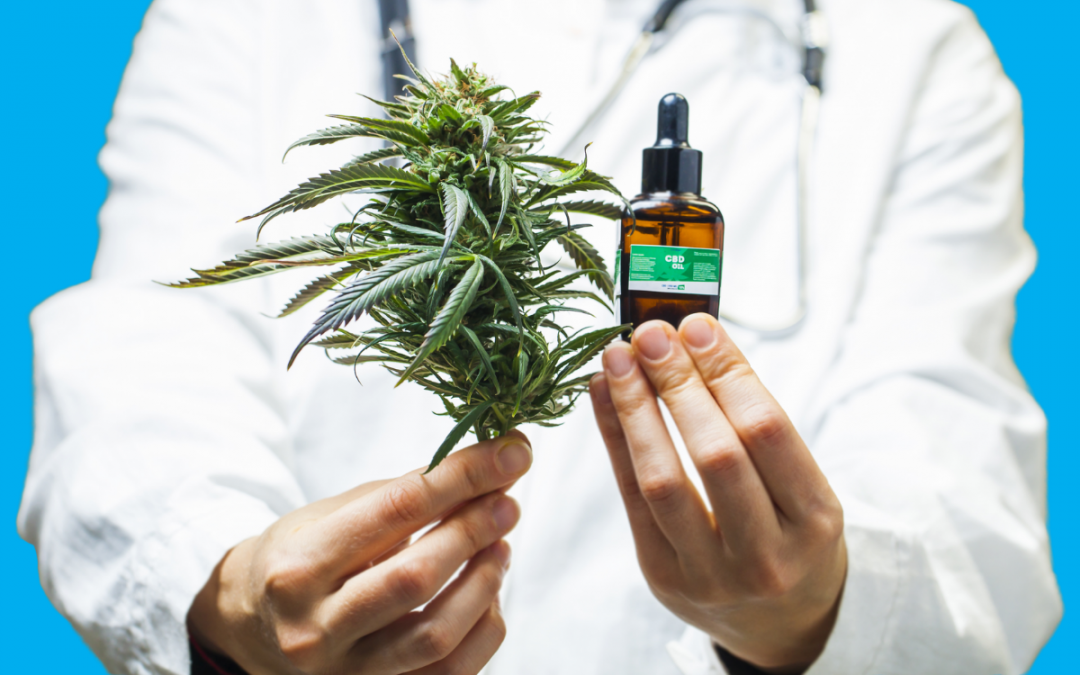More than 200 prescription medications could negatively interact with cannabis and CBD.
Today, more than 66% of adults take prescription medications. When we consider seniors over 65 years old, the medication rate skyrockets to nearly 75%, since chronic health conditions are more prevalent in older adults. Additionally, in the US nearly 25% of the population reports taking three or more prescriptions simultaneously.¹ ² ³
Prescription medications are often used to treat conditions for which there is no direct cure. People who suffer from mental health conditions or chronic diseases like arthritis, diabetes, and hypertension may rely on medication daily. Undoubtedly, prescription medications can go a long way to help us function and live happy, healthy lives.
However, many healthcare experts recognize that wellness plans aren’t one-size-fits-all. Now more than ever, individualized wellness and therapy plans include alternative and holistic approaches — including plant medicine and cannabis therapies.
Using CBD or cannabis as a part of your wellness routine, may leave you concerned about interactions between various products, strains, varietals and your prescriptions.
Some prescription and over-the-counter medicines may interact with cannabinoids like THC and CBD. To ensure safe use, it’s important to understand the unique effects of using cannabinoid therapies and your prescriptions together.
Your Mydna.live health portal can help you identify interactions between cannabinoids and your prescriptions medications.
Of course, you should always check with your healthcare provider before making changes to your wellness routines.
What is a drug to drug interaction?
Simply put, drug to drug interaction is when a drug’s expected effect is delayed, decreased, enhanced or complicated by another drug compound present in the body.
For example, if you take one medication to sleep a night (a sedative) and another to help with your seasonal allergies (an antihistamine), you may find it difficult or dangerous to operate heavy machinery or drive your car. This is because taking a sedative and an antihistamine at the same time can cause additional side effects that wouldn’t necessarily occur if the medications were taken independently.
Drug to drug interactions can occur when:
- Prescription medications are taken together;
- Certain food or supplements are taken with medication; or,
- Multiple drugs are introduced to the system simultaneously, like prescriptions and alternative medicines.
For example, perhaps your doctor recommends you avoid eating grapefruit while you’re on medication for high blood pressure or arrhythmia. That’s because grapefruit juice can block a special enzyme needed to break down and metabolize some medications. This means too much medication can enter the bloodstream and cause sudden, serious health effects.⁴
Although it’s less common, dietary supplements can also cause drug to drug interactions. Robert Mozersky, a medical officer at the Food and Drug Administration (FDA), says “Some dietary supplements may increase the effect of your medication, and other dietary supplements may decrease it.” For example, vitamin E is known to thin the blood. Combining vitamin E supplements with blood thinners may be a dangerous idea.⁵
Key Takeaway: Combining medications or therapies can lead to unintended effects. Some of these effects can be harmful. To safely use prescription medications and cannabis therapies, you must consider how they interact within the body.
Does cannabis interact with my medications?
Yes, there’s a chance that cannabis and cannabis derivatives may interact with your prescription medication. In fact, research has identified over 200 different prescription medications that interact with cannabis and CBD.
It’s also important to note that different varietals, strains, and products can have vastly different cannabinoid and terpene profiles, which can ultimately lead to different interactions. For this reason, it’s safest not only to know which prescription drugs interact with cannabis, but to use products with reliable profiles. You can find this information by asking your manufacturer or dispensary for a certificate of analysis to verify the cannabinoid ratios and prominent terpene profiles.
Formulations with identifiable CBD:THC ratios and primary, secondary, and tertiary terpene profiles can help you make informed decisions about matching cannabinoid products to your health needs. A consistent product means a consistent outcome. It also means reliable therapeutic results.
For more information about Endo·Aligned’s personalized cannabinoid formulations, click here.
Key Takeaway: Research has identified more than 200 different pharmaceutical medications shown to interact with cannabis and CBD. So even if your prescription is common, temporary, or you’re taking a low dosage, it may potentially interact with your cannabis therapy. For safe use, it’s important to use therapies and products with reliable CBD:THC ratios and terpene profiles.
How do cannabinoids interact with prescription drugs?
Though they can interact in a number of different ways within the body, cannabinoids and prescription drugs mainly affect each other’s therapeutic effectiveness during metabolism.
When you take prescription medications, your body gets to work breaking down the medicine into smaller components, so the medication can be put to use. This is not unlike the process to break down food and absorb its nutrients. After the drug is metabolized, it can be eliminated from the body through urine or feces.
The main organ responsible for metabolizing prescription medications is the liver (though the kidneys and intestines also play a role). The liver produces a set of drug metabolizing enzymes (DMEs) that specifically break down medications. Interestingly, specific DMEs can interact with CBD, THC, and other cannabinoid compounds.⁶
When the activity of DMEs is altered, certain prescription medications may not be metabolized efficiently or effectively. In some cases, interactions can have serious health implications.
Depending on the medication, a drug can interact with another in one of two main ways. It can act as an:
- Inhibitor; or,
- Inducer.
What is a drug inhibitor?
If a drug reduces the activity of a specific enzyme, it’s called an inhibitor.
For example, the enzyme CYP2C19 is responsible for metabolizing CBD and THC. Depending on genetic variations and innate activity of CYP2C19, some people are more sensitive to cannabis than others. If you take specific medications, they can inhibit (or reduce) the activity of CYP2C19 and cause levels of CBD to rise. This could potentially lead to unsafe levels in the blood, also called toxicity. Although more research is needed to determine appropriate daily recommendations, a recent study on mice proved that excess CBD in the blood may be harmful to the liver.⁷
For more information on how your genes affect your ability to metabolize CBD and THC, check out our board member Mike Tagen’s article here.
What is a drug inducer?
If a drug raises the activity of a specific enzyme, it is called an inducer.
For example, If you take specific medications, they can induce (or stimulate) the activity of CYP2C19 and cause levels of CBD to fall. This can lead to a diminished therapeutic effect and result in little to no relief from your inflammation, pain, anxiety, or other pesky symptoms.
Key Takeaway: Because cannabinoids interact with drug metabolizing enzymes (DMEs), which are needed to break down medications, certain pharmaceuticals or supplements should not be taken when using cannabinoids. The combination of cannabinoids and these medications can lead to too much or too little of a substance in the bloodstream.
How can drug to drug interactions affect my health?
Drug to drug interactions can cause a variety of responses within the body. Interactions that reduce the desired effects or increase the adverse effects of a given substance are of particular concern.
Adverse interactions can result in:
- Failure of therapy or medication;
- Toxic or harmful amounts of substance in the bloodstream;
- Increased frequency and severity of side effects; or,
- Unexpected or unusual symptoms.
Since drug interactions are complex chemical processes, interactions may not occur in every individual. Several factors that can influence the prevalence and severity of drug to drug interactions are:
- Genetics;
- Age;
- Lifestyle habits (including diet and exercise);
- Underlying conditions;
- Drug doses; or,
- Time of administration between drugs.
Although not all prescription drugs will interact with cannabinoid compounds, some may cause adverse events. For this reason, it’s important to make informed decisions and consult your healthcare provider about your cannabinoid use when taking prescription medications.
Key Takeaway: Drug to drug interactions can have serious health implications. They can lead to a decrease in the desired medication effects or an increase in adverse effects. Drug to drug interactions can be influenced by many factors including your genetics, underlying conditions, and drug dosing or timing. It’s important to talk to a healthcare provider if you take multiple medications and/or use cannabis therapy as a part of your wellness routine.
Your Mydna.live healthcare portal and Drug to Drug Interaction Report.
Endocanna Health has developed a drug to drug interaction tool to give you full access to information about how your prescription drugs interact with cannabinoids.
Your Endo·Decoded Report uses your unique genotype, the information you share in the medications survey, and the latest research and clinical information to create a wellness plan that includes drug to drug interaction alerts when providing suggestions for cannabinoid formulations, dosing, and matrix delivery.
Mydna.live has identified more than 200 prescription medications which may interact with CBD or THC. If you are currently taking any of the medications in our database, we’ll identify what type of interaction can be possible. We will never sell or share any information about the medications you are using.
Any conclusions we have reached regarding drug to drug interaction, is based on the current research in peer-reviewed studies, a thorough search in DRUGBANK, and evaluated against CPIC guidelines (Clinical Pharmacogenetics Implementation Consortium).
Your Mydna.live healthcare portal also includes Endo·Aligned suggested ratios and unique cannabinoid and terpene profiles to match your genetics, and dosing suggestions for you to discuss with your physician.
Key Takeaway: Endocanna Health has developed a drug to drug interaction tool to give you full access to information about how your prescription drugs interact with cannabinoids. To download a sample Endo·Decoded Report, click here.
Always consult your doctor about cannabinoid use and drug interactions.
It’s important to include your healthcare provider in any changes you plan to make to your medications, including adding any new medications or therapeutics, like cannabinoid formulations.
Sharing your Drug to Drug Interaction Report with your practitioner is highly encouraged.
To create a personalized wellness plan that is built and designed for your individual needs, upload your DNA kit, or order a new kit through Endodna.com.
References
- https://hpi.georgetown.edu/rxdrugs/
- https://www.cdc.gov/nchs/fastats/drug-use-therapeutic.htm
- https://www.kff.org/health-reform/issue-brief/data-note-prescription-drugs-and-older-adults/
- https://www.fda.gov/consumers/consumer-updates/grapefruit-juice-and-some-drugs-dont-mix
- https://www.fda.gov/consumers/consumer-updates/mixing-medications-and-dietary-supplements-can-endanger-your-health
- https://www.ncbi.nlm.nih.gov/pmc/articles/PMC6473892/
- https://www.mdpi.com/1420-3049/24/9/1694
Endocanna Health is a biotechnology company committed to helping consumers find the right cannabinoid products to enhance their health and wellness. Using our breakthrough DNA test, Endo·dna, we empower you to take control of your health with access to over 55 different health reports that include suggestions for the best CBD and cannabis products that match your unique genetic code. Visit us here to find out more!





